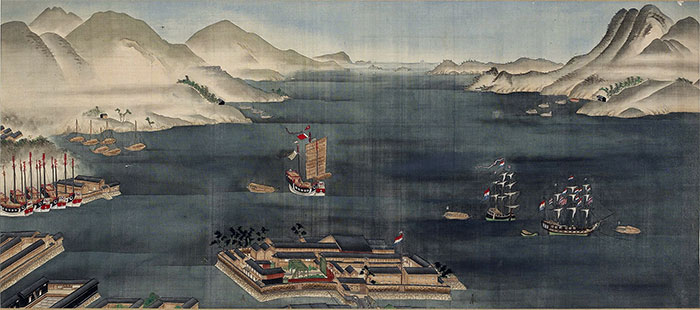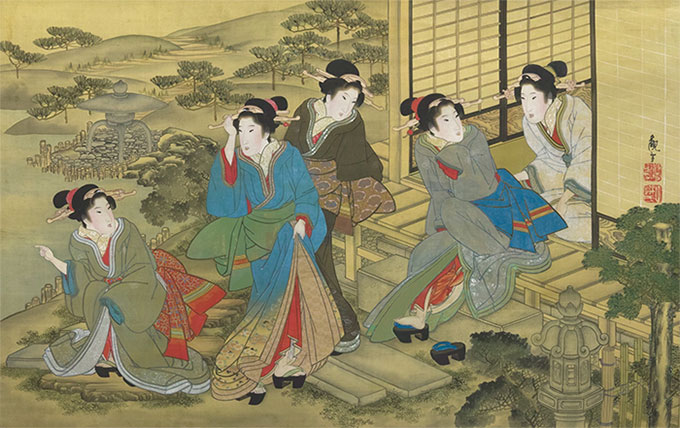The Japanese 'slow and sustainable lifestyle' stems from the policy that made the country isolated for more than 200 years
Around the beginning of the 17th century, at the dawn of the Edo period, fearing foreign influence through missionary activities, the Japanese government at that time, the Tokugawa shogunate, issued a policy of "Sakoku" seclusion. to prevent foreigners from entering the country and to prevent Japanese from leaving the country.

In the early 17th century, the Tokugawa shogunate issued a policy of "Sakoku" seclusion.
In terms of diplomacy and foreign trade, Japan at that time was almost completely foreign and domestic and lasted until 1868 when the Meiji dynasty began, which is more than 200 years.
Although this policy has stifled the country's cultural exchanges with other countries, according to The Conversation, it has allowed the unique culture, customs and way of life of the land of the rising sun to flourish. separately, much of which has been recorded in art forms that still exist today such as haiku or kabuki theater.
A self-sufficient but efficient economy
It also means that the Japanese, living under a heavily restricted system of trade, must rely entirely on locally available materials, creating an economy that emphasizes reuse and Recycling is on the rise.

The Japanese lived under a system of strict trade restrictions.
In fact, Japan is already self-sufficient in resources, energy and food but still maintains a population of up to 30 million people, using absolutely no fossil fuels or chemical fertilizers - an impressive number. Imagine an isolated island country, 80% of the area is mountainous.
The people of the Edo period led a lifestyle known today as "slow living", a set of sustainable living practices based on actively abstaining from waste. Not even light is wasted - daily activities begin at sunrise and end at sunset.
Clothes are sewn and reused many times until they are no longer usable. Ashes and waste are reused as fertilizer, leading to a thriving business for those who collect the substance and sell it to farmers. This can be called a primitive circular economy.

Painting scenes of life, washing clothes in the Edo period.
Fortunately, despite the quite thorough application of nationalism, the Tokugawa government was very aware of the economic situation of a pre-industrial East Asian country, which relied heavily on agriculture. The shogunate promoted the policy of reclamation and waste prevention for the whole land, especially the arable land area which was expanded and reclaimed continuously.
In addition to the improvement of the irrigation system, Japanese agriculture in this period was still able to produce output to feed tens of millions of people.
Moreover, continuing to focus on developing industry, commerce, and crafts in a fairly hardworking society and lasting peace has created conditions for the development of the commodity economy, playing a role in accumulating wealth for the development of the economy. The emergence of a new class in the Edo period - the bourgeoisie as well as the wealthy peasantry, was the impetus for the Meiji Restoration.
Harmony with nature
Another feature of the slow life is the use of the calendar and the measurement of seasonal time. In countries influenced by East Asian culture and pre-modern Japan, the 12 zodiac signs (known in Japanese as juni-shiki) is the common way used to divide a day into 12 hours, each hour. roughly equal to 2 modern hours.
During the Edo period, that system was used to divide the time between sunrise and sunset into 6 hours can chi. Therefore, an hour can chi has a wide variety of lengths depending on whether it is measured in summer, winter, night or day (especially in a country located at high latitudes like Japan). The idea of regulating life by immutable units of time like modern minutes and seconds simply doesn't exist.

The painting depicts Kōnosu-shuku station on the Edo-Kyoto celestial road in the early 19th century.
Instead, the Edo people - who did not own clocks - measured time by the sound of bells installed in castles and temples. Allowing the natural world to govern life in this way has given rise to a sensitivity to the seasons and their abundance, naturalness, and abundance, helping to develop a friendly set of cultural values. with the environment.
From the mid-Edo period onwards, rural industries and crafts - including cotton and oil production, silkworm rearing, paper making, and the production of sake or miso - began to flourish. People hold seasonal festivals with a rich and varied variety of local foods, pray for fertility during the cherry blossom season, and express gratitude for the autumn harvests.
This unique, eco-friendly social system was born partly out of urgency, but also out of the profound cultural experience of living close to nature. This needs to be absorbed in the modern age to achieve a more sustainable culture - and there are some modern activities the Japanese still practice that can help.
For example, zazen, or "meditation," is a practice from Buddhism that can help people create a peaceful and quiet space to experience the sensations of nature. Today, some urban temples are still holding meditation sessions for citizens.
The second example is "forest bathing" (shinrin-yoku), a term coined by the head of Japan's forestry agency in 1982. There are many different types of forest bathing today, but the most common form. The best way is to spend time away from electronic devices to immerse yourself in the peace of a forest.
Such activities can help develop an appreciation for the beauty of nature, which in turn can lead us to a more sustainable way of life – a way of life that residents of Edo period Japan appreciated. high.
In an era where the need for a more sustainable lifestyle has become a global issue, we can respect the wisdom of the Edo people, who live with a changing time frame, cherishing materials. and promote recycling.
- Banana stalks and incredible benefits
- Dance screen of colorful paint drops under slow-motion view
- The relationship between personality and human lifestyle
- 20 photos of Chinese crowds
- Singapore: attracting foreign doctors thanks to the policy
- The life expectancy of people depends on the factors that are unbelievable
- To be happy, take the initiative to change your lifestyle
- Google's worst privacy policy in the world
- Discovering ancient Vietnamese tombs dating back thousands of years
- What factors helped Japan become the safest country in the world?
- Why is the browser running slow and how to fix it?
- The 15 most isolated cities on Earth
 Biography of hero Vu A Dinh
Biography of hero Vu A Dinh History of hematology
History of hematology Who is Mr. Tam Da 'Phuc-Loc-Tho' and what does it mean?
Who is Mr. Tam Da 'Phuc-Loc-Tho' and what does it mean? Unbelievable facts about the history of the oil and gas industry: Gasoline used to be cheaper than water, so abundant that it had to be dumped into the river...
Unbelievable facts about the history of the oil and gas industry: Gasoline used to be cheaper than water, so abundant that it had to be dumped into the river...